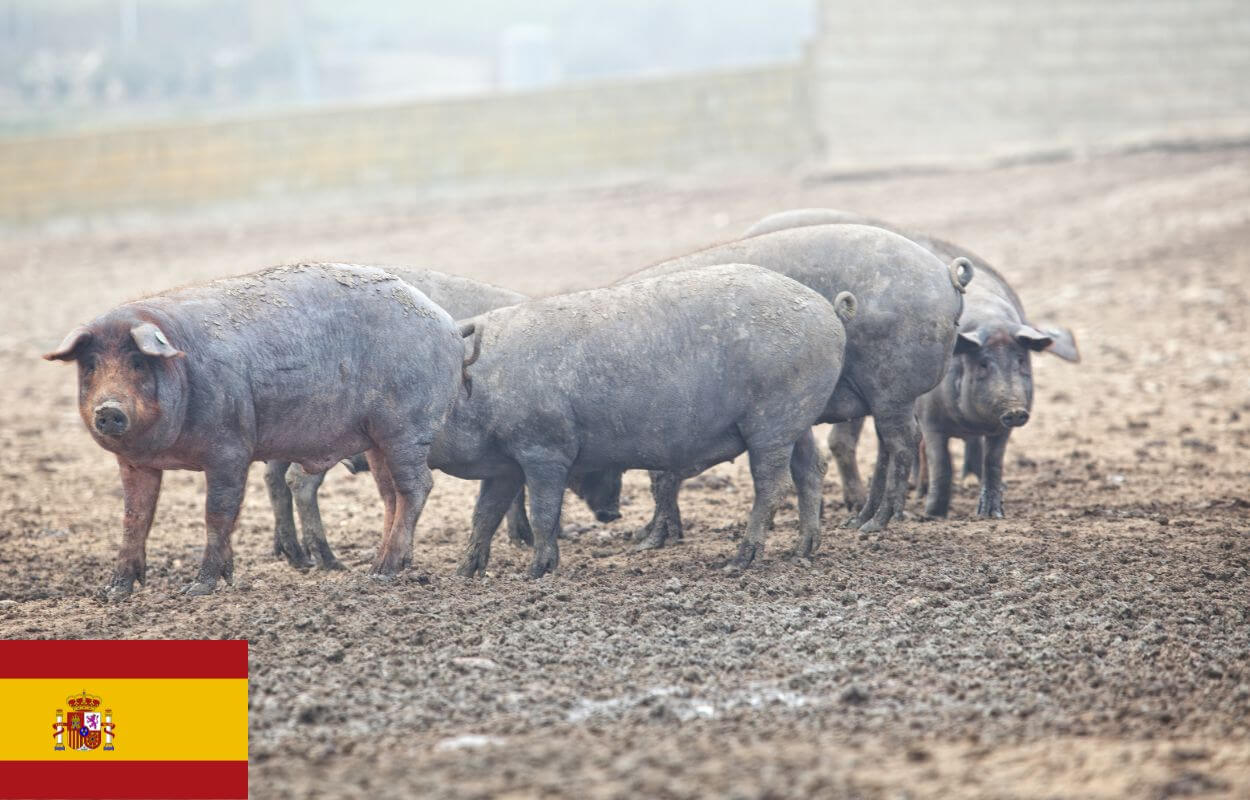
As pig farmers, we are constantly looking for ways to diversify, improve and increase our profits. One way to do this is to explore the breeds of pigs that can be sold at higher prices or generate more profit.
The Black Iberian Pig is one of the pig breeds that are famous for producing some of the most expensive pork in the world. However, earning this title is not simple and depends on various factors, with what the Black Iberian Pig eats being the most important one.
But let’s find out more important details about these pigs, such as their feeding habits, growth rate, meat quality, advantages and disadvantages, and when the Black Iberian Pig can be a suitable choice for a pig farm.
Contents
History and Origin
The Black Iberian pig has a rich and long history, and it is strongly connected to the process of animal domestication.
The Black Iberian Pig originated in the Iberian Peninsula and is one of the oldest pig breeds discovered. It was brought there by the Phoenicians, who are from present-day Lebanon.
The Phoenicians introduced the pig to the Iberian Peninsula and interbred it with other wild boars.
This pig is representative of the Neolithic period when humans started to domesticate different animals in Spain and the central and southern parts of Portugal. The Black Iberian pig was one of the domesticated animals that also learned to adapt to pastoral settings.
What is a Black Iberian Pig?
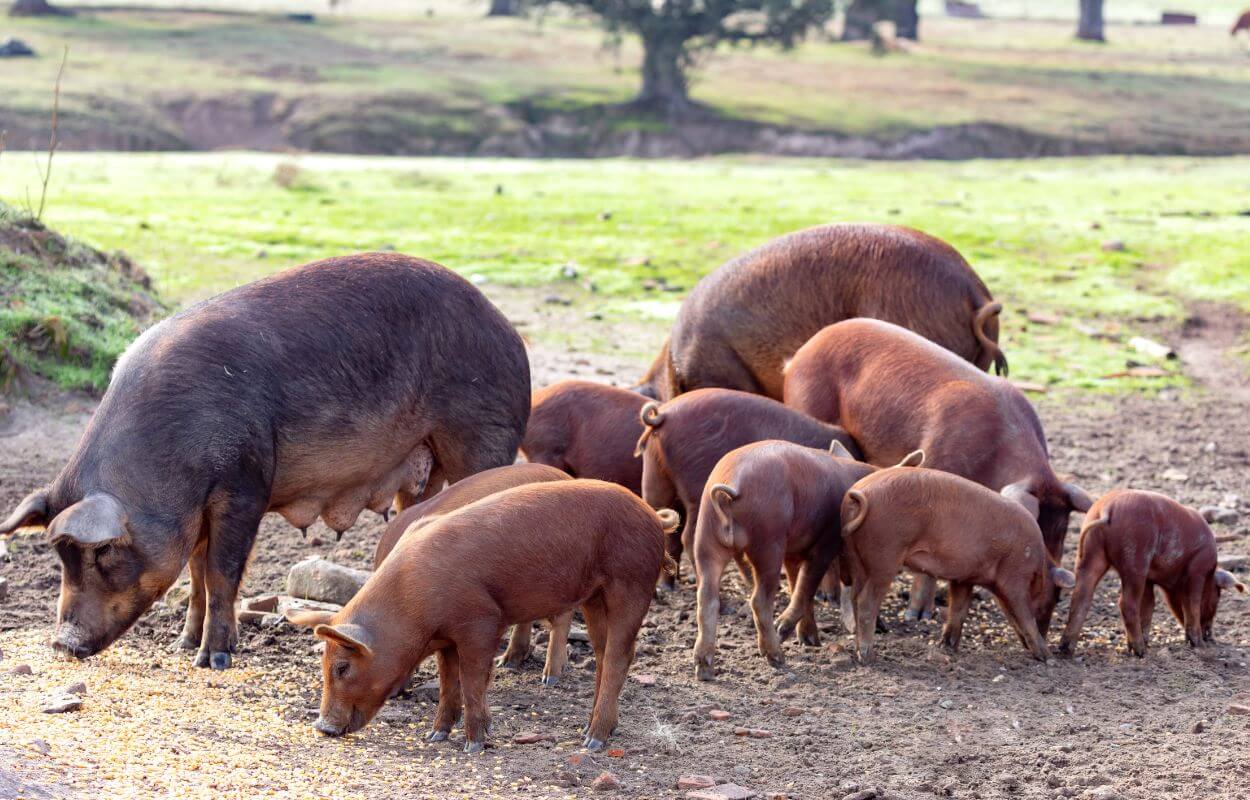
A Black Iberian pig, also known as the Iberian pig or Pata Negra, is a domestic pig, a traditional pig breed of the Iberian Peninsula, and one of the rarest pig breeds that have had a large influence on the ecosystem.
This pig played an essential role in restoring the oak forests in the Iberian Peninsula.
Black Iberian Pig Characteristics
Easily recognizable at a single glance, the Black Iberian pig possesses truly distinctive characteristics that set it apart from all other pig breeds.
Physical Characteristics
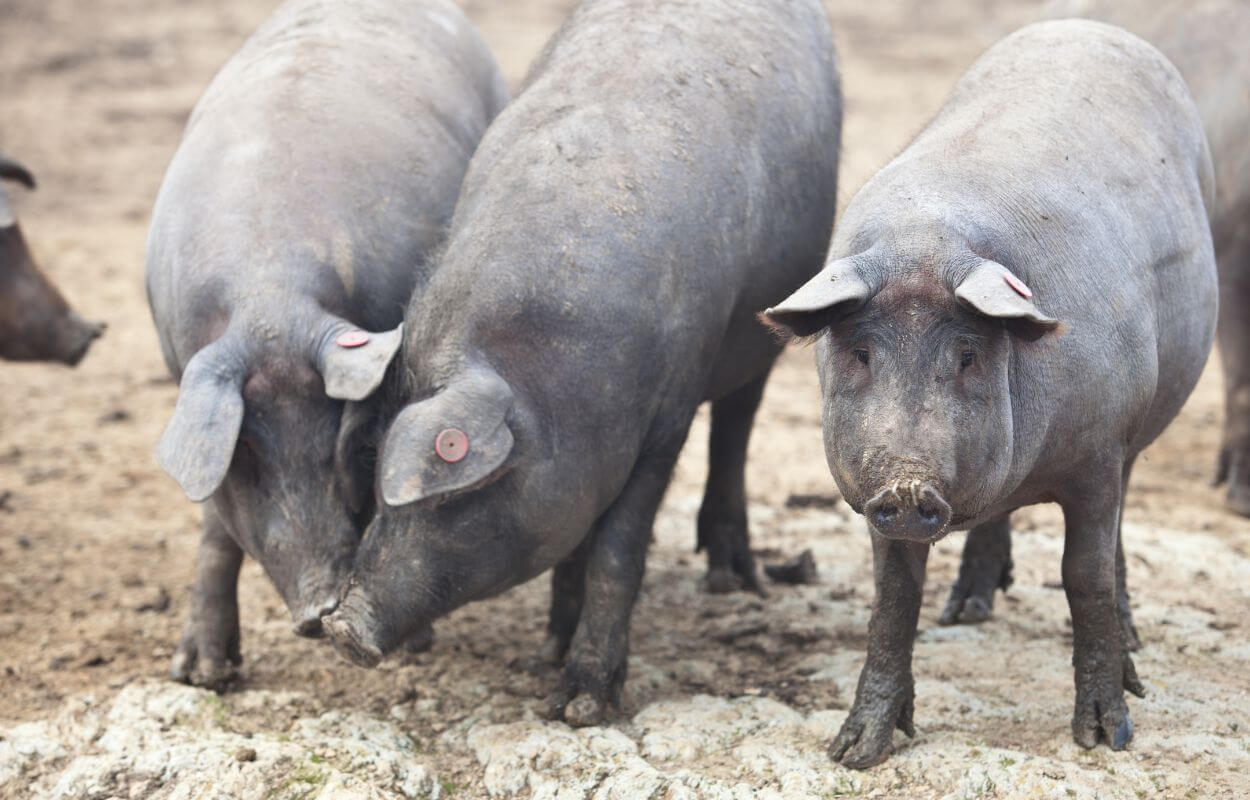
Color
The color of the Black Iberian pig is black, as the name suggests. But, it can also vary, ranging from dark brown to dark red or dark orange in the case of different crossbreeds.
Size
The size of the Black Iberian pig is medium. Both male and female Black Iberian pig measures between 33 to 34 inches (84-86 cm).
Hair
This pig has little to no hair on its body, but rather dark skin. In comparison to other hairy pig breeds like Mangalica or Idaho Pasture pig, the Black Iberian pig is actually hairless or bald.
Head, Face, Snout, Ears
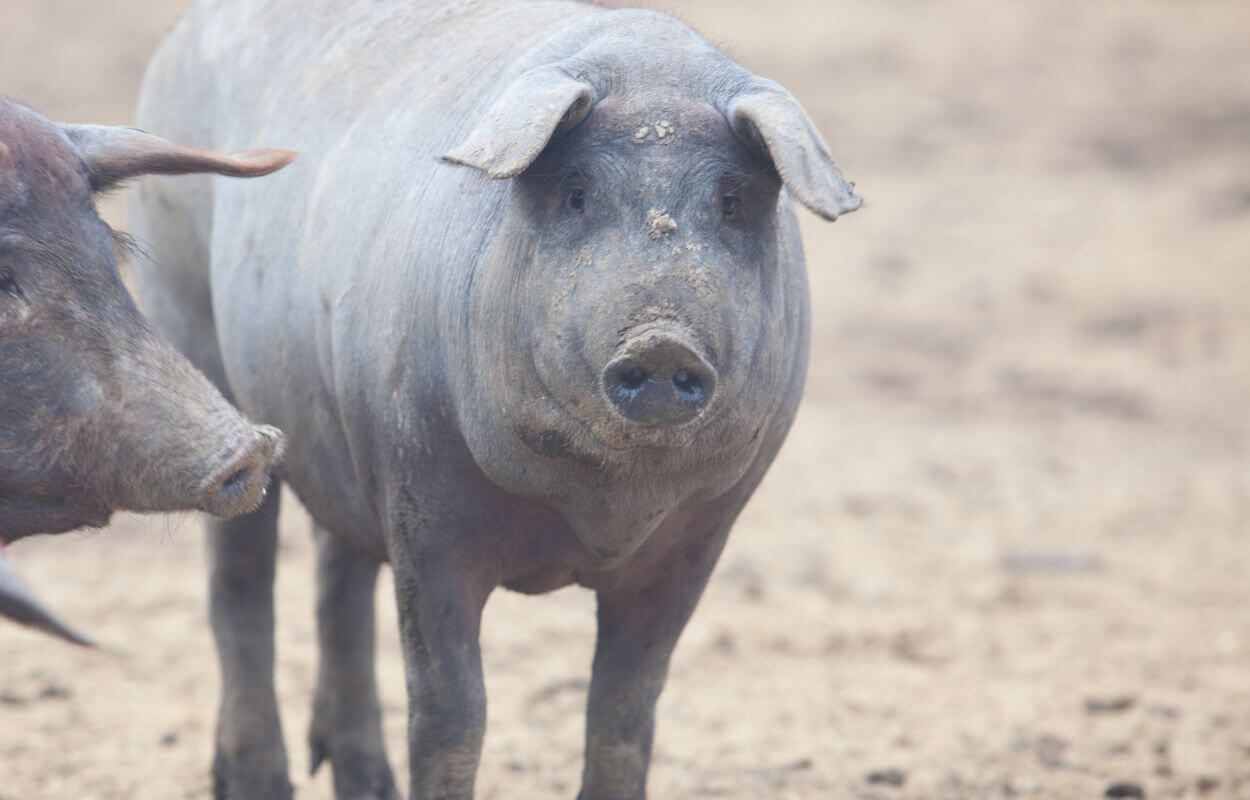
The head of this pig is well-proportioned to its body, neither too large nor too small. The face is long, featuring small eyes and well-defined jowls. The snout is small to medium size and straight, while the ears are medium-sized and have a visor shape.
Teeth
The teeth of Black Iberian pigs may not be sharp, but they possess significant biting strength when it comes to food.
Tusks
Black Iberian pigs, both males and females, can develop tusks.
Males generally have longer tusks, while females have shorter ones that typically do not extend beyond the mouth. As a result, tusks can be one of the distinguishing characteristics used to identify the gender of Black Iberian pigs.
Body, Chest, Back, Teats
The main body of the Black Iberian pig is compact, robust, and muscular, with a broad back and a deep chest.
It also has well-developed shoulders and hindquarters, which contribute to its strength and mobility. In terms of teats, the Black Iberian pig typically has between 10 and 12.
Legs
The legs of the Black Iberian pig are long and sturdy.
Unlike some other pig breeds, the Black Iberian pig does not experience issues with its legs, as they are capable of easily supporting its body weight.
Tail
The tails of Black Iberian pigs are often short and naturally curly.
Lifespan
The Black Iberian pig has an average lifespan of 15 to 18 years.
This can vary depending on factors such as maintenance, diet, genetics, and overall health.
Overall, this pig has good longevity compared to other pig breeds with shorter lifespans, such as the Chester White.
Growth Rate
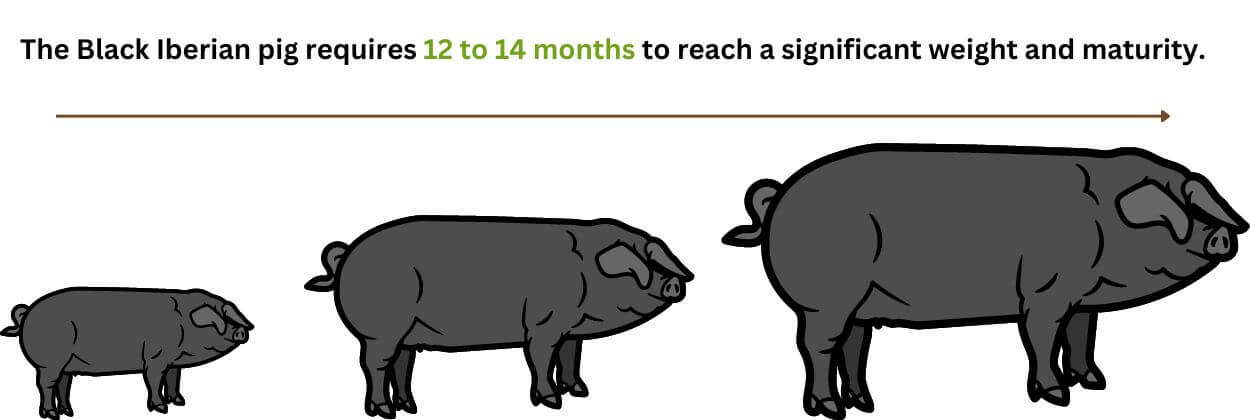
The growth rate of Black Iberian pigs is slower compared to some other pig breeds.
It is not as slow as the growth rate of Mangalica pigs, but it is also not as fast as that of Piétrain pigs.
How fast do Black Iberian pigs grow?
The Black Iberian pig requires 12 to 14 months to reach a significant weight and maturity.
The duration of this growth period depends on factors such as individual growth rates, diet, and the specific objectives of the farmer.
For a medium-sized pig, it is interesting that it has the same growth rate as the miniature pig breed Kunekune.
Although they do not grow as rapidly as some other breeds, Black Iberian pigs reach sexual maturity at around 6 to 7 months of age, which is consistent with the typical timeline for most pigs.
Weight
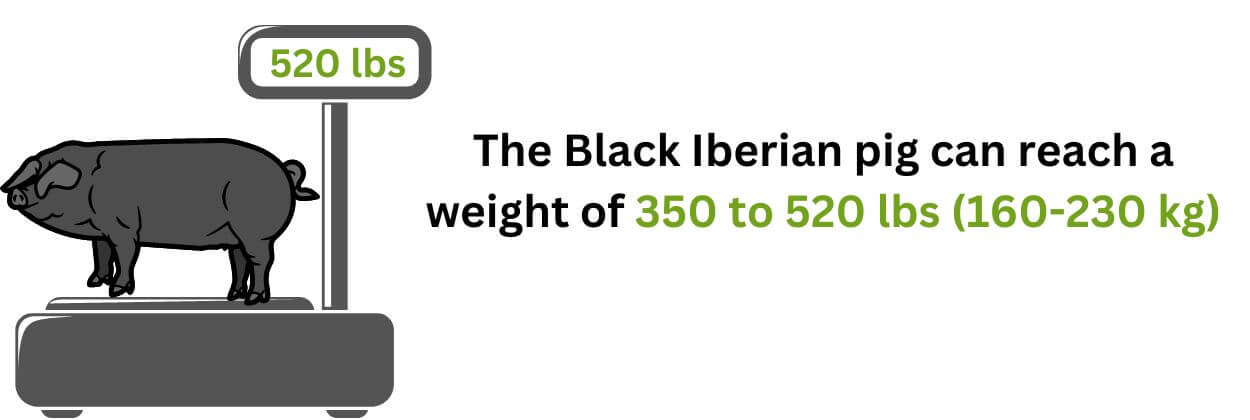
The Black Iberian pig can reach a weight of 350 to 520 lbs (160-230 kg), but it can also exceed 530 lbs (240 kg) if allowed to fatten.
In general, female Black Iberian pigs weigh less than their males.
According to various studies that have gathered extensive data, the rate of daily weight gain among Black Iberian pigs is highly diverse. There is a significant variation in the growth rates of individual pigs, with some exhibiting faster weight gain while others have slower rates.
A Black Iberian pig can experience a daily weight gain ranging from 0.37 to 0.8 lbs (0.16 – 0.35 kg) per day during the lactation period, 1.7 lbs (0.77 kg) per day during the overall fattening stage, and 2.2 lbs (1 kg) per day from 286 lbs (130 kg) onwards.
Slaughter Time
According to the Denomination of Origin (DO) regulations in Spain, a Black Iberian pig can be slaughtered at a minimum of 14 months of age if it is fed with acorns. Field bait pigs can be slaughtered at a minimum of 12 months of age.
These regulations govern various aspects, including geographic area, breed, and genetics.
For example, a pig can be a purebred Iberian, while another can be a crossbreed with a high percentage of Black Iberian pig genetics.
Temperament and Behaviour
Black Iberian pigs are usually calm, but they can be less friendly compared to other breeds of pigs.
They are not aggressive by nature, but they have a higher level of overall confidence than purely domesticated pig breeds.
They still have wild instincts, which means they tend to avoid people, quickly see their surroundings as dangerous, and run away when they feel scared.
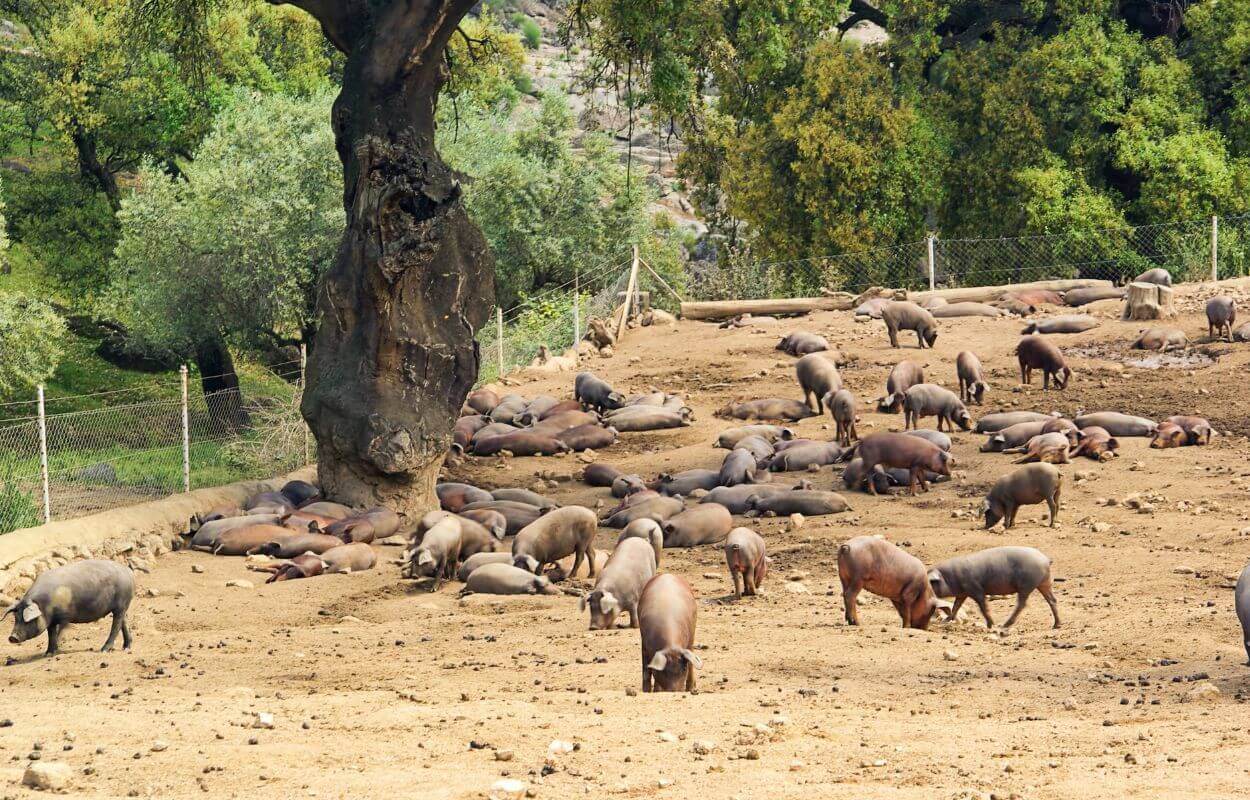
While being semi-wild, Black Iberian pigs have remarkable curiosity, intelligence, and adaptability. Their ability to adapt well allows them to coexist together with humans, eventually accepting their presence without seeing them as a danger.
By dedicating sufficient time to communicate and interact with these pigs, they can become great farm animals to be around and care for.
Black Iberian pigs have strong foraging and grazing instincts. They are highly skilled at finding their own food and exploring their environment through foraging behavior.
They are also very energetic and love to exercise and stay active. Their muscular bodies are a result of their highly active lifestyle and constant physical activity.
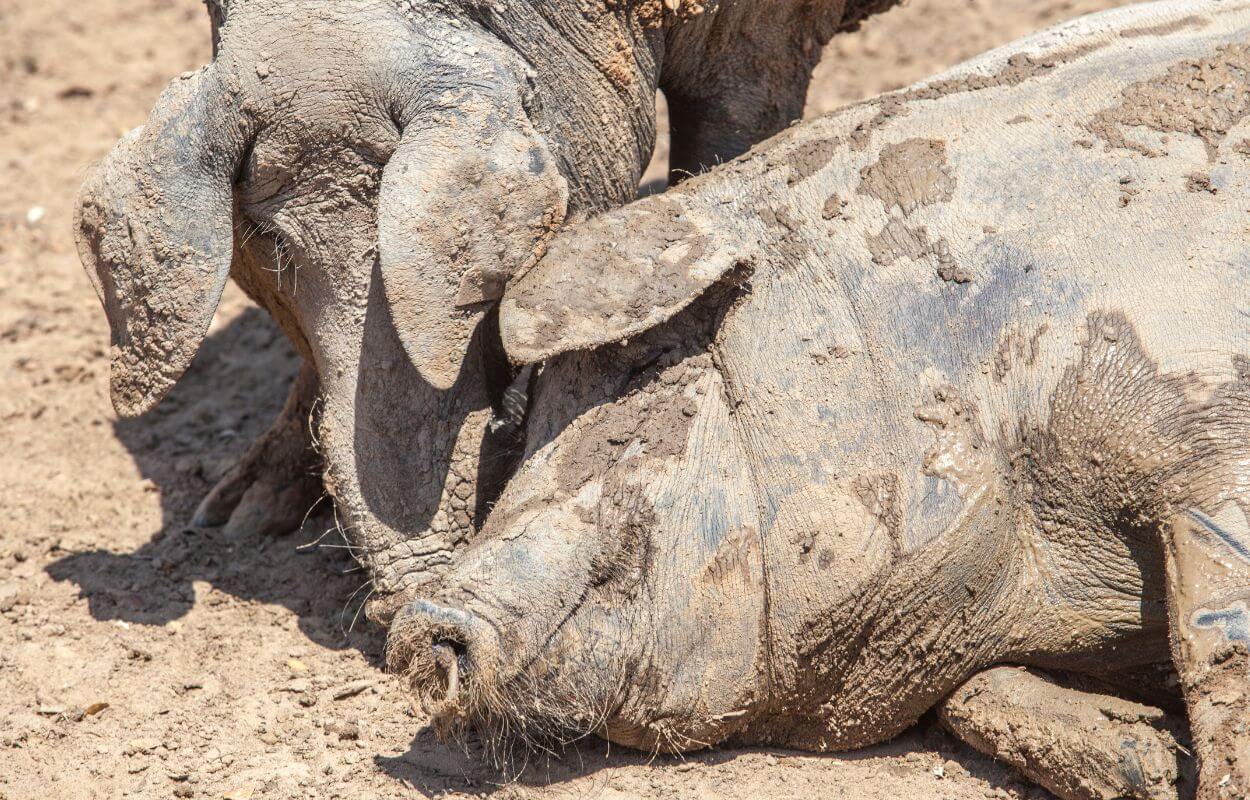
When they are not exercising, they socialize within a group or herd, establishing hierarchies and displaying a certain level of cooperation among different levels.
Overall, despite their slightly less friendly attitude, these pigs can adapt. However, it also depends heavily on the conditions and practices on each farm, as they can directly impact the behavior and temperament of these pigs.
Black Iberian Pig Meat
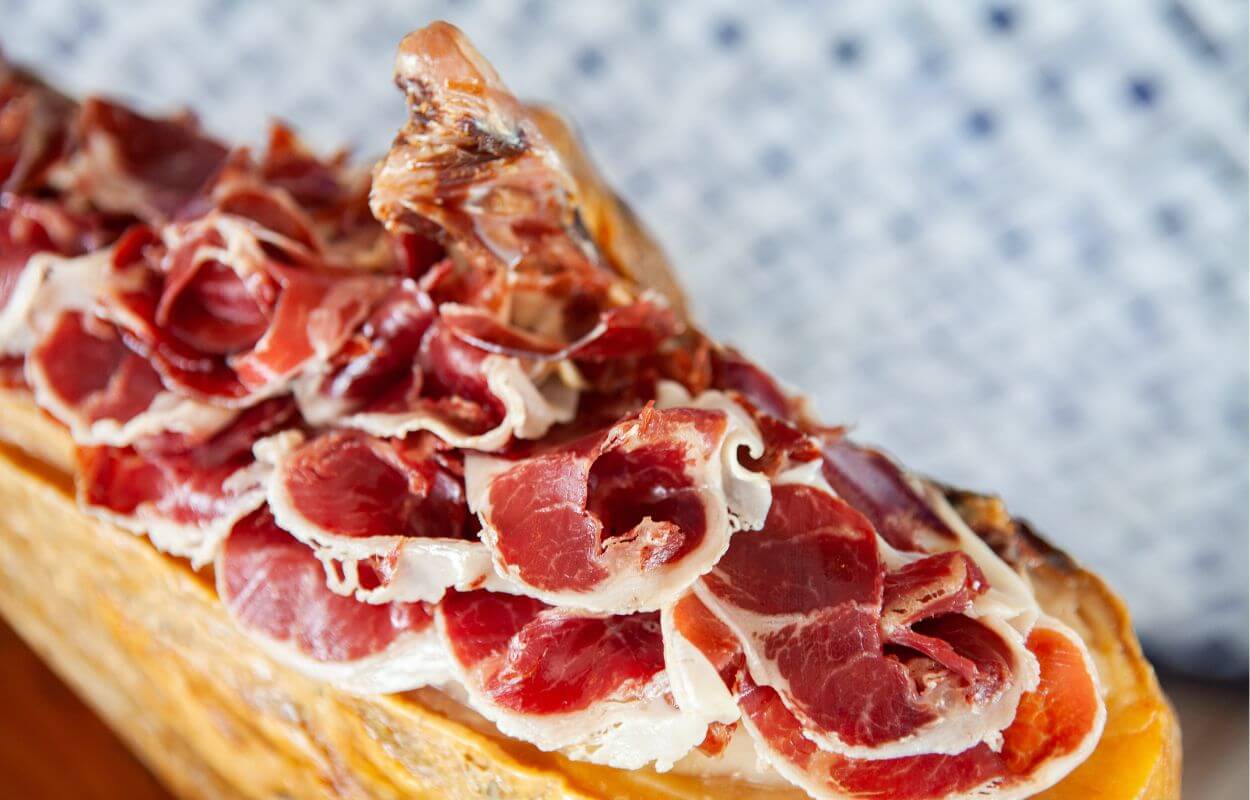
If you’re wondering what these pigs are known for, the answer is quite simple: the Black Iberian pigs are renowned for their high-quality and flavorful meat.
The meat of Black Iberian pigs is deep red, similar to beef, and has a rich, intense nutty, and sweet flavor.
This unique taste comes from their diet, which primarily consists of acorns. They are known for their specific diet and the ritual before they are butchered.
Another distinctive feature of this meat is its marbling. Due to the pigs’ extended growth period, they accumulate intramuscular fat within the muscle. The fat is evenly distributed, resulting in fine lines throughout the meat. The marbling enhances the tenderness, juiciness, and flavor of the meat.
But that’s not all. The fat content also contributes to a smooth and buttery texture, causing the meat to melt in your mouth.
The fat in Black Iberian pigs is healthy due to its high content of monounsaturated oleic acid. This type of fat is beneficial for human health as it helps combat bad cholesterol.
Furthermore, the meat of this pig is high in vitamin A, vitamin E, iron, lots of antioxidants, and tyrosine.
The most popular product made from the meat of Black Iberian pigs is the traditional cured ham from Spain and Portugal, known as Jamón Ibérico.This ham is prepared using the pig’s leg and undergoes a variety of processes until it reaches its final form.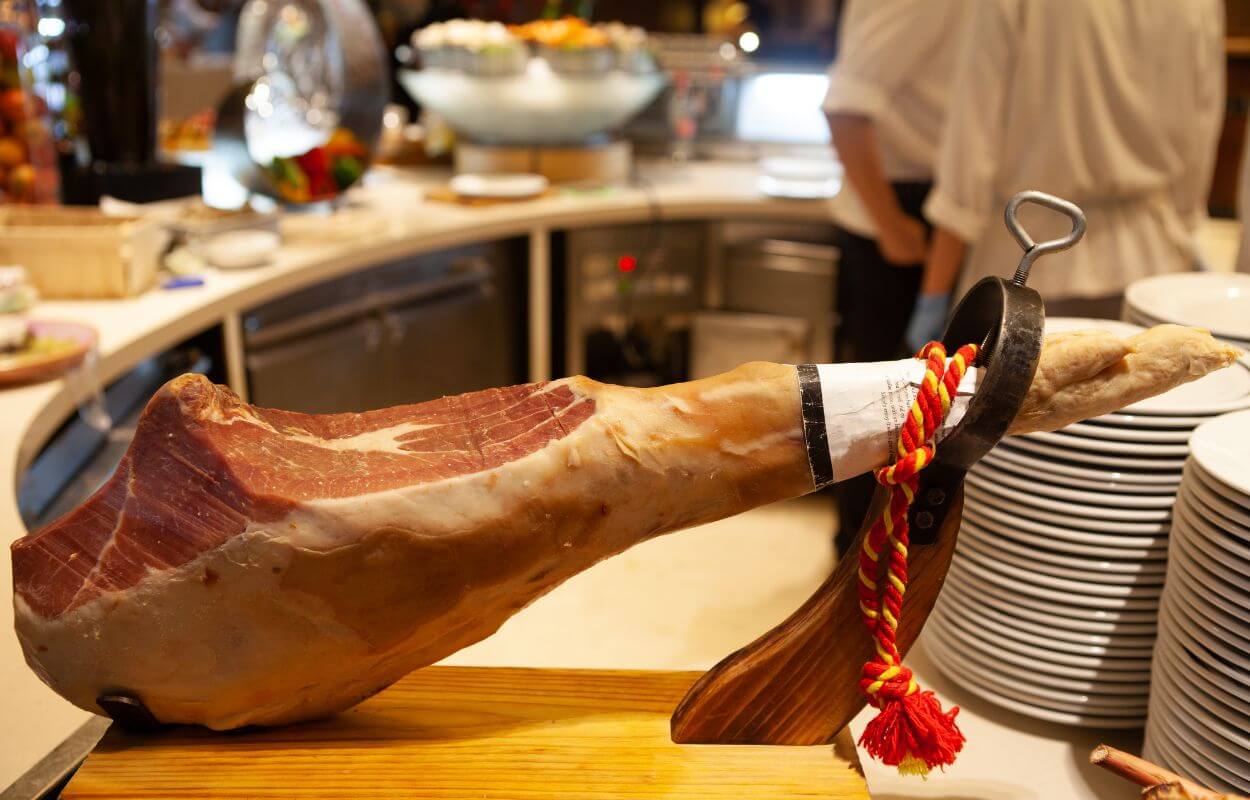
The following types of hams are made from Black Iberian pig’s meat:
- Jamón Ibérico de Bellota 100% – Commonly known as “pata negra,” this ham is derived from pigs with both parents being 100% Iberian or purebred. These pigs enjoy a free-range lifestyle, grazing on acorns in the pasture during the autumn and winter months. Following the pig’s slaughter, the ham leg is salt-cured for a duration of 36 to 49 months, with the specific time determined by the weight of each piece.
- Jamón Ibérico de Bellota 50% – For this particular ham, the pig can have only 50% Iberian heritage. This occurs when a 100% Iberian mother is bred with pigs from other breeds, such as Duroc.
- Jamón Ibérico de Cebo de Campo – For the production of this ham Iberian pigs with 50 and 75% Iberian heritage are used. These pigs are still raised in an open range, but they are fed fodder, cereal, wild fruits, and no acorns.
- Jamón Ibérico de Cebo 50% – This ham is made from an Iberian breed pig that has been raised on a farm with no free access to pasture and fed exclusively with cereals during its adulthood.
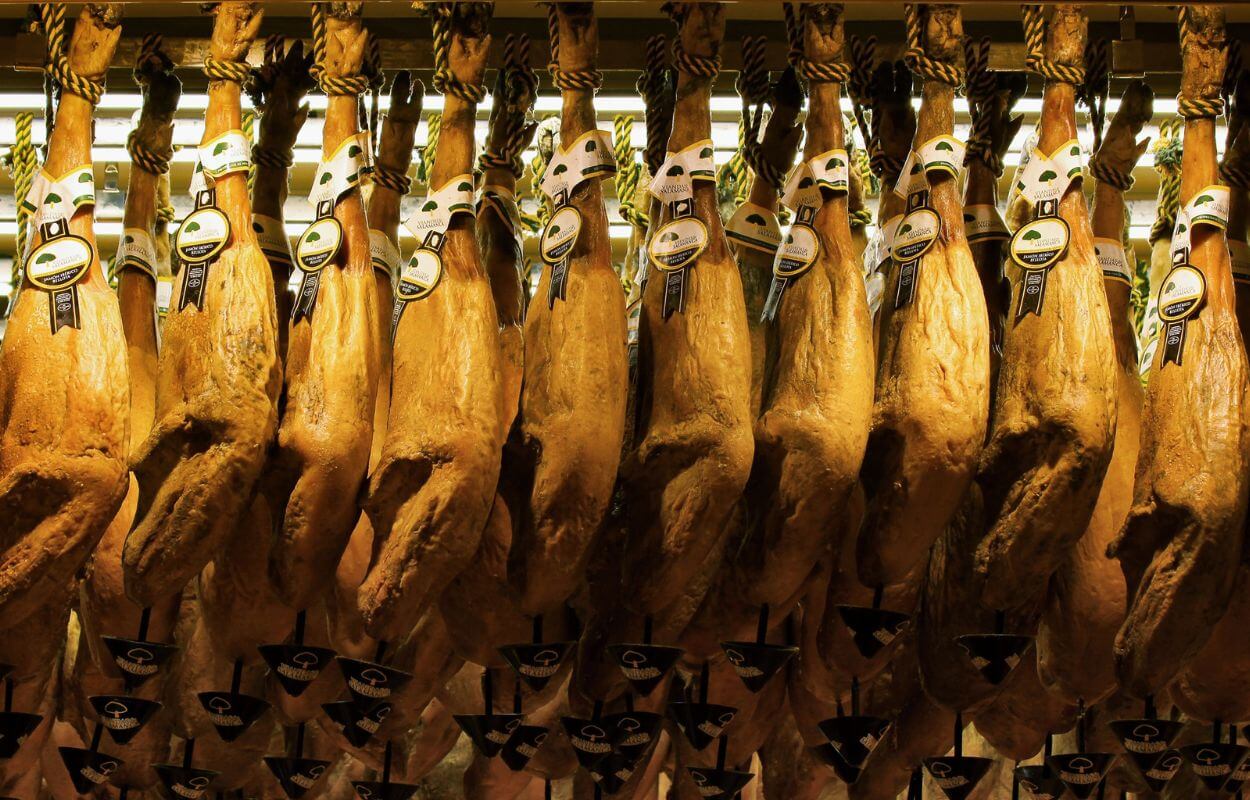
Their meat can also be used in various culinary dishes and can be prepared as cuts for grilling or roasting. There are several types of pork cuts you can get from Iberico pigs.
- shoulder loin
- shoulder steaks
- ribs
- pork belly
- pork rack
- tenderloin
Growing Black Iberian Pig
Feeding
Black Iberian pigs primarily eat acorns, especially from October to March, as well as grass, legumes, herbs, and fruits.
But Black Iberian pigs can be fed in various ways, but it all depends on the final goal of the pig farmer.
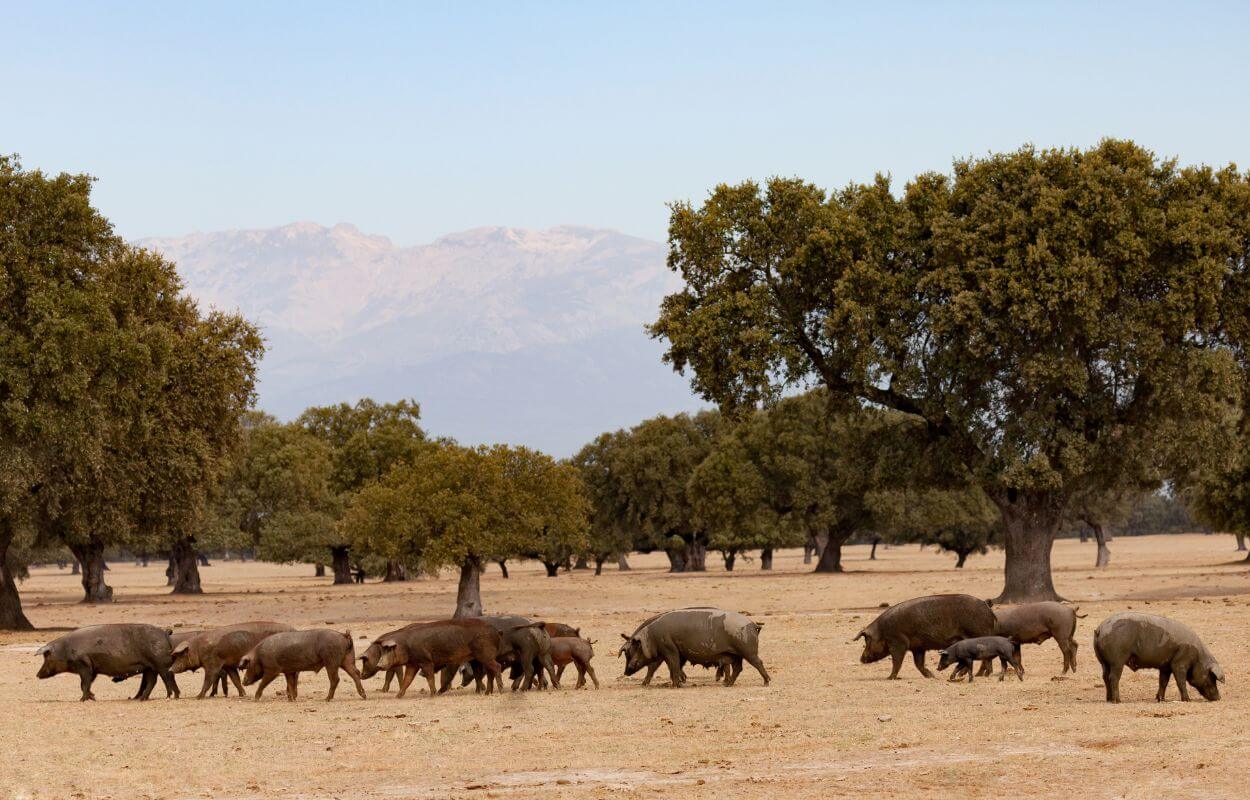
When feeding and raising a Black Iberian pig, the pig farmer needs to consider in advance their intentions for the meat, whether they plan to sell it or use it for other purposes, as well as the desired quality they aim to achieve.
1. Acorn-fed Black Iberian Pig
If you want to raise purebred Black Iberian pigs with the purpose of producing specialties such as Jamón ibérico de Bellota 100%, you need to ensure that you feed your Black Iberian pigs a lot of acorns, grass, and herbs.
Ideally, you should raise or accommodate them in a Mediterranean ecosystem with abundant oak trees that produce acorns.
If this is not possible, you can consider purchasing acorns to feed them. It’s important to note that these pigs do not consume acorns year-round but should have access to them during the “montanera” season in Spain, which typically runs from October to February and March.
For the remaining months of the year, from March to October, you can feed your Black Iberian pigs with cereals and fruits if they are available.
2. Diet of the Black Iberian Cebo de Campo Pig
You can still raise these pigs even if you do not have a Mediterranean ecosystem nearby or the possibility to buy acorns.
So, what can you feed Black Iberian pigs in this case?
An alternative would be to feed your Black Iberian pigs fodder, cereals, wild legumes, and all kinds of fruits such as wild fruits, and let them wander freely on the pasture, giving them the opportunity to feed themselves with plenty of fresh grass.
Because of the free access to pasture and fresh grass, you can still obtain high-quality meat. Although it may not have the nutty flavor of acorn-fed meat, it is still great in its own right.
3. Diet of the Black Iberian Cebo Pig
No acorns and no pasture? No worries! It is still possible to raise a Black Iberian pig indoors and feed them only with cereals.
As a result of their limited access to open spaces for exercise and the absence of wild grass in their diet, their meat is expected to have diminished flavor profiles, aromas, and textures.
Still, the meat is good, and you can easily obtain a Jamón Ibérico de Cebo ham.
Environment
The ideal environment for the Black Iberian pig is undoubtedly an open pasture, a free space filled with fresh grass and oak-rich trees that produce acorns.
This type of environment, known as the dehesa ecosystem, is typically found in southwestern Spain and Portugal.
An open pastureland with diverse vegetation and plenty of oak trees provides everything a Black Iberian pig requires in its diet to develop nutty-flavored and high-quality meat.
Climate
Black Iberian pigs thrive in a Mediterranean climate, characterized by hot, dry summers and mild, wet winters.
The warm summers and mild winters of the Mediterranean climate allow them to graze on pasture and flourish in their natural free environment.
While Black Iberian pigs are commonly found in the Mediterranean region of southwestern Spain and Portugal, they can also be raised in other climates with the necessary adjustments to meet their requirements.
For instance, in colder climates, providing shelter and appropriate heating would be essential to protect the pigs from extreme temperatures.
Shelter
Black Iberian pigs are hardy, resilient, and well-adapted to their environment, but they can still benefit from the advantages of having a shelter, particularly when raised in non-Mediterranean environments.
While they are used to having access to shade from trees, providing shelter can offer additional protection against extreme heat, heavy rain, or harsh winds. It also serves as a comfortable resting place for the pigs during unfavorable weather conditions.
How many Black Iberian pigs per acre?
You can raise 2 Black Iberian pigs per acre or 1 Black Iberian pig per hectare.
These numbers apply to land or areas with a healthy dehesa or montanera ecosystem. The ecosystem is characterized by extensive grazing land consisting of grassland and oak trees.
Each Black Iberian pig is able to eat up to 22 lbs (10 kg) or more acorns a day.
Fact: The size of a dehesa in Spain can vary, but typically it ranges from a few hundred acres/hectares to several thousand acres/hectares. Dehesas occupy 5.68 million acres (2.3 million hectares) in Spain and 1.73 million acre (0.7 million hectares) in Portugal
Breeding Black Iberian pigs
Black Iberian pigs are a terminal pig breed, primarily bred for meat production.
They are often crossed with other pig breeds to produce offspring with superior meat qualities.
Black Iberian sows are primarily used for breeding purposes, as they may have limited maternal instincts.
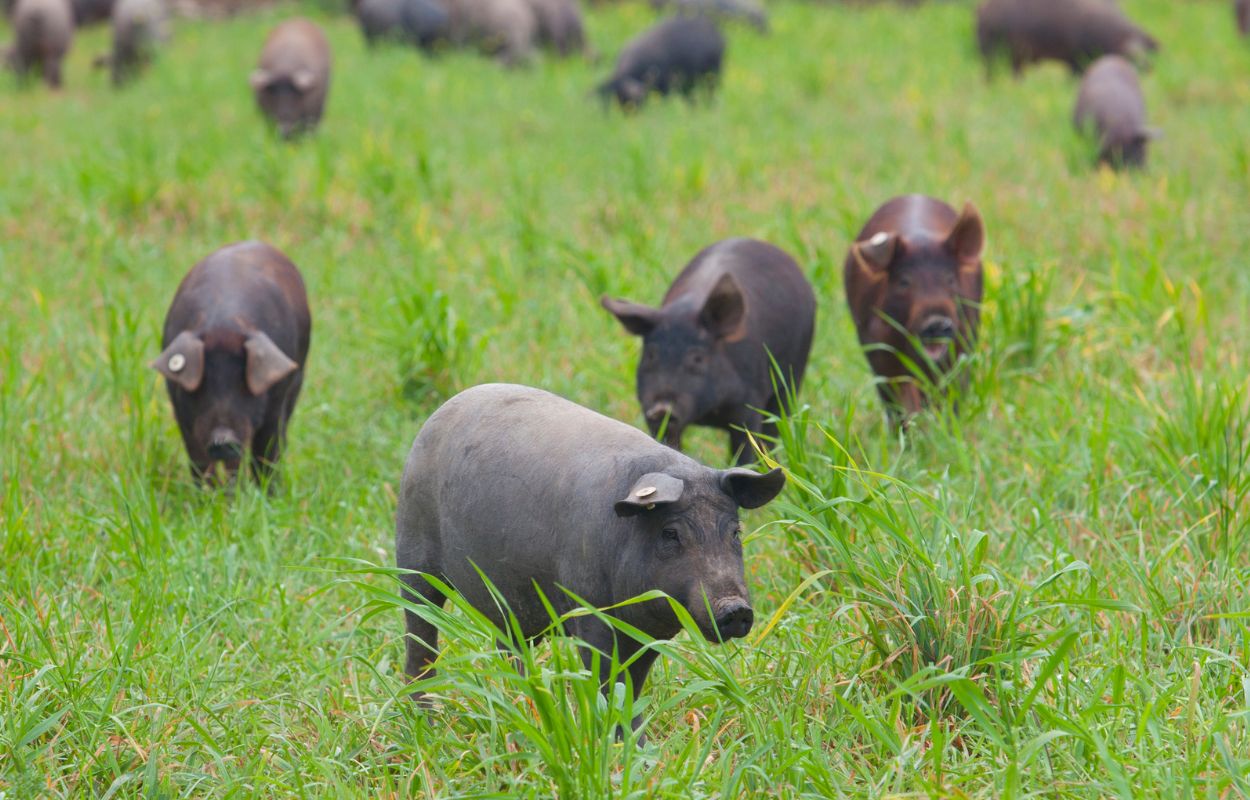
The reproductive cycle of Black Iberian pigs typically occurs once or twice per year, with a gestation period of around 114 to 115 days or approximately 3 months, 3 weeks, and 3 days.
Black Iberian gilts reach sexual maturity at 6 to 7 months, but it is recommended to wait until they are 9 to 10 months old before starting breeding.
The average litter size for Black Iberian pigs is 7 to 8 piglets.
The farrowing process for Black Iberian pigs is generally smooth, and the sow typically does not require assistance during delivery.
The breeding process of Black Iberian pigs typically involves the following steps:
- Determine the breeding method you prefer, whether it’s natural breeding or artificial insemination.
- Select healthy, purebred Black Iberian pigs with desirable traits suitable for breeding.If you opt for artificial insemination, ensure you have access to the semen of a purebred boar.
- Monitor the female pig for signs of heat, such as increased vocalization, restlessness, and receptiveness to the boar’s presence.
- Once the female is in heat, proceed with the breeding process.
- After breeding, closely monitor the sow for pregnancy. Provide appropriate nutrition and care, ensuring a comfortable and stress-free environment.
- Prepare a designated area specifically for farrowing, ensuring it is well-equipped for the birthing process.
Vaccination
The Black Iberian pigs, like any other pig breed, require vaccinations. If you choose to raise these pigs, you can simply follow the standard pig vaccination chart applicable to all pig breeds.
Health Issues
Despite their hardiness, Black Iberian pigs are still susceptible to various pig diseases, including serious ones like Coccidiosis, Exudative Dermatitis, Swine Dysentery, Porcine Parvovirus, Mastitis, and respiratory issues such as coughing and sneezing.
All these health issues can be avoided through vaccination.
Another specific health issue of Black Iberian pigs is poor eyesight due to facial structure. Their eyes are positioned in a way that may give the appearance of limited peripheral vision.
Why should you raise Black Iberian pigs?
Profitability
Black Iberian pigs are definitely worth raising as they can generate profits for small farms. Still, the profitability can vary depending on different scenarios.
Let’s look at each scenario individually:
1.
One of the most profitable situations is when you raise purebred Black Iberian pigs fed with acorns from October to March and allow them to exercise freely on a pasture or forest.
To achieve this, you should have:
– a dehesa or oak forest that produces ample acorns.
– sufficient space for the pigs to run and graze freely.
A Black Iberian pig raised in this manner typically costs $5000 to $5500.
Also, the meat from this type of Black Iberian pig is very expensive. Spanish Jamón Ibérico ham has a price of $150 to $300 per pound, and a whole leg can range from $1600 to $4000, depending on the length of the curing period.
2.
Another scenario that can bring you money is when you choose to raise pigs with 50% or 75% Black Iberian genetics, without including acorns in their diet.
They are fed a combination of fodder, cereals, fruits, and legumes, and having access to an open space for physical activity is also beneficial.
In this case, all the prices are half of those for pigs fed with acorns, including the price for leg or produced ham.
Also, if you raise a purebred Black Iberian pig but it is not fed with acorns, its price is also halved.
Personal Use
Personally, I would say that Black Iberian pigs would not be my first choice for raising homesteads.
This is because they require a significant amount of space for grazing and foraging, they do not have the same desirable carcass qualities as other breeds, and they can be wild and aggressive in nature.
Can Black Iberian pigs be raised in a homestead? Yes, they can be raised in a homestead, particularly in cases where there is ample land available for them to roam, graze, and forage.
So, if you are a homesteader looking for a challenge, you can consider raising this breed. However, I must say that if you are new to pig farming, try to start with another breed such as Hereford pig or Gloucestershire Old Spots.
Advantages and Disadvantages
As with any other pig breed, raising Black Iberian pigs comes with its own set of advantages and disadvantages.
| Advantages | Disadvantages |
|---|---|
| High-quality meat with a nutty flavor. | Limited availability. |
| Ability to graze and forage. | Expensive prices. |
| Hardiness and sturdiness. | Requires specific environmental conditions. |
| Independence. | Requires a specific diet |
| Good lifespan. | A longer time to mature |
| Limited maternal instincts | |
| Lower litter size | |
| Less friendly compared to some breeds |
Overall, while Black Iberian pigs offer exceptional meat quality and foraging abilities, their requirements and characteristics may present challenges for some breeders.
Black Iberian Pig Facts
Here are some more interesting facts about the Black Iberian pig:
1. Today, the Black Iberian pig is predominantly present in the southwestern regions of the Iberian Peninsula, namely West Andalusia, Extremadura, and the province of Salamanca.
2. In the Portuguese region of Alentejo, this particular breed of pig is referred to as Porco Alentejano, with minor variations.
3. In Spain, Black Iberian pigs are also commonly known as “Jabugo Pigs”.
4. The Black Iberian pig is not regarded as a rare breed, as evidenced by the existence of 4,370 registered Iberian pig farms, 375,500 breeding sows, and 4,780 boars as of November 2017.
In 2017, the number of slaughtered pigs reached 3,240,000, indicating a 35% growth compared to 2014, a period marked by economic challenges and a surplus crisis in the industry.
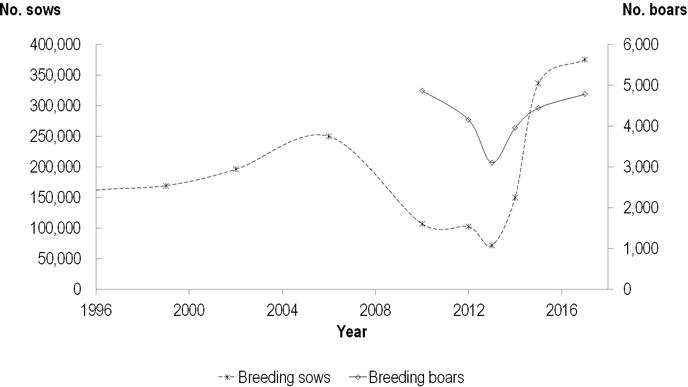
5. Spain is the primary producer of Black Iberian pigs.
6. All Black Iberian pig hams have special labels that follow the rules of a unique labeling system:
- Jamón Ibérico de Bellota 100% has a black label.
- Jamón Ibérico de Bellota 50% has a red label.
- Jamón Ibérico Cebo de Campo has a green label.
- Jamón Ibérico de Cebo 50% has a white label.
7. One of the interesting aspects of bellota hams is the conversion of saturated fats into healthy mono-unsaturated fats containing significant levels of oleic acid.
The presence of antioxidants in the acorns and the unique curing method results in the conversion of saturated fats into beneficial mono-unsaturated fats, rich in oleic acid.
8. Black Iberian pig is one of the most expensive pigs in the world.


